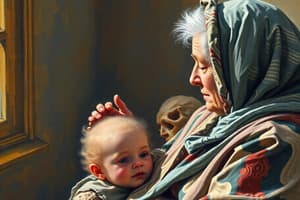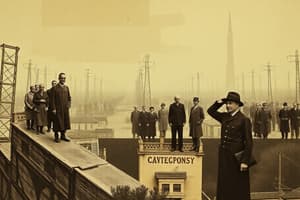Podcast
Questions and Answers
What is the most significant factor influencing life expectancy?
What is the most significant factor influencing life expectancy?
- Gender (correct)
- Reduced death of children
- Race
- Ethnicity
What is the average life expectancy in 2022?
What is the average life expectancy in 2022?
- 79.05 years (correct)
- 80.4 years
- 78.7 years
- 77.6 years
Which of these is not a source of income for elders?
Which of these is not a source of income for elders?
- Supplemental Security Income
- Social Security
- Pensions
- Student Loans (correct)
What is a common characteristic of minority elder groups?
What is a common characteristic of minority elder groups?
Which of these is not a factor that influences longevity?
Which of these is not a factor that influences longevity?
What is the theoretical limit on the length of life?
What is the theoretical limit on the length of life?
What is the average Social Security income for a man in 2005, according to the text?
What is the average Social Security income for a man in 2005, according to the text?
Which group of elders is the fastest growing and least educated minority?
Which group of elders is the fastest growing and least educated minority?
What is the average life expectancy for a male in the United States?
What is the average life expectancy for a male in the United States?
What is the leading cause of preventable death in the US?
What is the leading cause of preventable death in the US?
What is a potential benefit of quitting smoking for a 65 year old?
What is a potential benefit of quitting smoking for a 65 year old?
What specific chromosome group is associated with longevity?
What specific chromosome group is associated with longevity?
What impact does the X chromosome have on potential longevity in females?
What impact does the X chromosome have on potential longevity in females?
Which of these is NOT a characteristic of individuals who are more likely to live with family, be poor, and unable to speak English?
Which of these is NOT a characteristic of individuals who are more likely to live with family, be poor, and unable to speak English?
What is the main federal law focused on providing social and nutrition services for older people?
What is the main federal law focused on providing social and nutrition services for older people?
What percentage of elders in 2009 lived in metropolitan areas?
What percentage of elders in 2009 lived in metropolitan areas?
Which of the following is NOT a characteristic of ageism?
Which of the following is NOT a characteristic of ageism?
What is the main difference between ageism and simply acknowledging the physical changes that come with aging?
What is the main difference between ageism and simply acknowledging the physical changes that come with aging?
What is the primary focus of 'labelling' in the context of ageism?
What is the primary focus of 'labelling' in the context of ageism?
How does 'our nation's elders' being defined as those aged 65 and over contribute to ageism?
How does 'our nation's elders' being defined as those aged 65 and over contribute to ageism?
Which of the following statements best describes the relationship between ageism and discrimination?
Which of the following statements best describes the relationship between ageism and discrimination?
Which of the following factors is not directly associated with increased life expectancy?
Which of the following factors is not directly associated with increased life expectancy?
What is the primary reason why marriage may promote longevity?
What is the primary reason why marriage may promote longevity?
What is the primary focus of the "Random Theory of Aging"?
What is the primary focus of the "Random Theory of Aging"?
Which of the following factors is NOT mentioned in the text as being associated with a reduced lifespan?
Which of the following factors is NOT mentioned in the text as being associated with a reduced lifespan?
Which of the following is NOT a potential benefit of regular exercise?
Which of the following is NOT a potential benefit of regular exercise?
Which of these conditions is described in the text as being comparable to high blood pressure?
Which of these conditions is described in the text as being comparable to high blood pressure?
Which of these is a physiological theory of aging?
Which of these is a physiological theory of aging?
Based on the content provided, which of the following statements best reflects the relationship between environmental factors and longevity?
Based on the content provided, which of the following statements best reflects the relationship between environmental factors and longevity?
Flashcards
Ageism
Ageism
Discrimination and stereotyping based on age, particularly against older people.
Assumption in Ageism
Assumption in Ageism
Believing traits of older individuals are solely due to their age rather than other factors.
Labelling Older Individuals
Labelling Older Individuals
Assigning negative characteristics to older adults based on their age.
Discrimination Against Elders
Discrimination Against Elders
Signup and view all the flashcards
Defined Elders
Defined Elders
Signup and view all the flashcards
Genetic Diseases
Genetic Diseases
Signup and view all the flashcards
Acquired Diseases
Acquired Diseases
Signup and view all the flashcards
Obesity and Mortality
Obesity and Mortality
Signup and view all the flashcards
Height and Longevity
Height and Longevity
Signup and view all the flashcards
Physical Activity
Physical Activity
Signup and view all the flashcards
Alcohol Use
Alcohol Use
Signup and view all the flashcards
Marital Status and Longevity
Marital Status and Longevity
Signup and view all the flashcards
Biological Theories of Aging
Biological Theories of Aging
Signup and view all the flashcards
Elders' Self-Identification
Elders' Self-Identification
Signup and view all the flashcards
Demography
Demography
Signup and view all the flashcards
Growth of Elderly Population
Growth of Elderly Population
Signup and view all the flashcards
Life Expectancy
Life Expectancy
Signup and view all the flashcards
Gender Influence on Life Expectancy
Gender Influence on Life Expectancy
Signup and view all the flashcards
Home Ownership Among Elders
Home Ownership Among Elders
Signup and view all the flashcards
Impact of Marital Status
Impact of Marital Status
Signup and view all the flashcards
Older Americans Act
Older Americans Act
Signup and view all the flashcards
Social Security
Social Security
Signup and view all the flashcards
Chronic Conditions in Elders
Chronic Conditions in Elders
Signup and view all the flashcards
Poverty Among Minority Elders
Poverty Among Minority Elders
Signup and view all the flashcards
Centenarian Studies
Centenarian Studies
Signup and view all the flashcards
Impact of Smoking
Impact of Smoking
Signup and view all the flashcards
Educational Attainment in Elders
Educational Attainment in Elders
Signup and view all the flashcards
Heredity and Longevity
Heredity and Longevity
Signup and view all the flashcards
Study Notes
Demographics of Older Adults
- Older population is growing rapidly (⅛ in 2009, ⅕ projected by 2030), primarily due to baby boomers reaching older age and better healthcare.
- Life expectancy has increased from 77.6 in 2003 to 79.05 in 2022.
- Gender is the biggest factor influencing life expectancy, with females living longer.
- Racial and ethnic diversity significantly impacts health outcomes.
- In 2009, most elders owned their homes and lived in metropolitan areas.
- Highest elderly population concentrations are in California, Florida, New York, and Texas.
Marital Status and Living Arrangements
- Widows and widowers are significantly affected by the differing life expectancies.
- Marriage often correlates with better health outcomes and socio-economic factors, including higher household incomes.
- Most elders live in family settings with other individuals.
- Divorce rates are increasing amongst elders. A small proportion reside in nursing homes.
The Older American Act (OAA)
- Federal law (signed 1965) providing social and nutritional services to older adults, focusing on dignity and maintaining well-being.
Health and Education
- Most elders have at least one chronic condition (over 92%).
- Formal education levels are generally lower compared to younger generations, although Baby Boomers have been the most educated cohort. Educational attainment differs by race and ethnicity.
- Elders are often lifelong learners.
Income and Financial Security
- Social Security (established 1935) is a primary income source and reduces financial vulnerability, particularly for men.
- Supplemental Security Income (SSI, established 1974) assists aged, blind, and disabled individuals.
- Other income sources include personal assets, savings, home equity, pensions, and IRAs.
- Significant income disparities exist between racial and ethnic groups.
Health Status & Healthcare
- Elders often face challenges in seeking healthcare due to various factors, including historical and systemic issues.
- Minority elders experience higher poverty levels and racial discrimination, with black elders being approximately 20% poverty-stricken in 2009.
- Hispanic elders, a rapidly growing group, often have lower education levels and higher obesity/diabetes rates.
Longevity and Life Span
- Life span is the theoretical limit of human life (approx 115-120 years).
- Life expectancy is the average number of years a person is predicted to live.
- Research into longevity factors includes examining actuarial data, animal studies, longitudinal studies, and centenarian studies
Factors Influencing Longevity
- Heredity: Centenarians often have long-lived relatives.
- Lifestyle Factors: Diet, activity levels, stress management, and parenting styles contribute.
- Gender: Females generally live longer due to potential genetic and hormonal factors.
- Race and Ethnicity: Socioeconomic factors related to race and ethnicity often impact longevity.
- Smoking: Smoking is a leading preventable cause of death, significantly reducing life expectancy in both men (13.2 years) and women (14.5 years).
- Genetic and Acquired Diseases: Presence of chronic conditions and genetic predispositions affect life expectancy.
- Body Weight & Height: Obesity is linked to premature death and disability.
- Physical Activity: High levels of physical activity help reduce mortality rates.
- Alcohol Use: Moderate alcohol use benefits cardiovascular health. For heavy drinkers (3 or more drinks/day), life expectancy decreases.
- Marital Status: Married individuals tend to live longer than widowed or divorced individuals.
- Physiological Factors: Personality traits (like calmness) can influence longevity.
- Socioeconomic Factors: Higher education and income are often associated with longer lifespans.
- Environmental Factors: Radiation and air pollution negatively correlate with longevity.
Biological Theories of Aging
- Two primary theories explain aging:
- Random Theory: Accumulation of errors and damage within cells.
- Programmed Theory: Aging is determined by genetic characteristics.
Studying That Suits You
Use AI to generate personalized quizzes and flashcards to suit your learning preferences.




